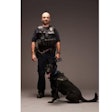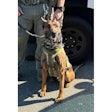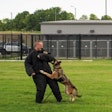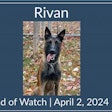Understanding the massages behind gang graffiti can shed some light on investigations.
It can be seen on delivery trucks, walls, mirrors, drinking glasses, clothes, doors-just about any surface. For gangsters, these markings are the "newspapers" of the gang subculture, representing everything from boundaries and challenges to friendly greetings and disciplinary actions. It can even be a motivating factor behind gang-related homicides.
Obviously, not all graffiti is gang graffiti. Much of the writings seen on the nation's highways or city walls are the byproducts of taggers, whose graffiti is more artistic in nature and distinguished by murals with bubble-type letters.
But once you are able to decipher their source and secret messages, graffiti becomes a useful source of information.
Setting Boundaries
Gang graffiti can be written in a variety of writing styles. Large block or stick letters are most commonly used, whereas Hispanic gang graffiti is usually more intricate.
Most of us realize that the Crips identify with blue colors and the Bloods with red. But the color will also help determine if you are dealing with a Hispanic gang or whether they are claiming North or South allegiance. It also can help investigators determine inter- vs. intra-gang rivalries.
Outside California, for instance, the red and blue colors represent a significant affiliation for Hispanic gangs. Hispanic gangs that have aligned themselves with those originating in Northern California will identify with the red color. Those Hispanic gangs that originate in Southern California will identify with the blue color.
Colors other than red or blue may have special significance for some groups that practice occult religions: many identify themselves with silver and red graffiti. Color has no real significance for many of the Midwestern gangs: the "Folk and People Nations" gang, based in Chicago, uses just about any color in their graffiti.
For turf-oriented gangs, the graffiti will act as a territorial boundary like a silent advertisement. Gang members and their allies recognize such markings as a form of greeting-a sort of "welcome home."
For rival gangs, the graffiti becomes a form of warning and challenge. The graffiti is a "stay away" signal and, at the same time. It says, "Beware, this is our turf-we're No. 1 here. What are you going to do about it'?" It is an insult for a rival gang to violate the warnings. For many turf gangs, the graffiti becomes like a road map, saying it is either safe or dangerous here.
Beyond the Alphabet
Boundary markers may be as simple as a gang name or symbol. Some may include a partial gang roster and denote gang affiliation. A classic example is Hispanic gang graffiti. Typically, it will tell the reader the gang name, indicate a Northern or Southern California orientation and have a claim of superiority over other gangs. It might contain the Roman numeral "13" in some form, which represents the 13th letter of the alphabet-the letter "M." Some of the younger gangsters say it stands for marijuana.
The number actually represents a bit of history for Hispanic gangs, referring to the Mara Villa housing project in 1940 Los Angeles. (Historically, one can trace the origin of turf rivalries for Hispanic gangs back to that era.)
In the California state prison system, the number "13" also is a symbol for the Mexican mafia, more commonly known as the "Eme." If the gang originates in Northern California, expect to see the number 14-the 14th letter of the alphabet, "N," which represents Norteno (north).
In the graffiti you should also expect to see "Sur" or "Sureno," another indication that the gang is from Southern California.
Some gang sets, or "cliques," are geographically located in different parts of the city or county. Gang graffiti may contain directional descriptions like north-side (NS), south-side (SS), eastside (ES) and westside (WS).
Many gangs-including Skinheads, Black, Tagger Crews and Hispanic -may all claim their Southern California alliance.
But gangs will indicate exactly what part of Southern California they're from via their telephone area codes. In San Diego, for example, the Impe gang-short for the city of Imperial, Calif.,-uses the numerals "619" in their gang graffiti (or they might spell it out).
Another common symbol in Hispanic gang graffiti is the letter "R" or the word "Rifa," both of which are short for "we are the best," or "we are No. I." Many gangs are now using the Spanish word, "somos," which stands for "we are" and placing it on top of the gang roster. It can be abbreviated as "SMS," and is usually accompanied by a list of gang "monikers" (a name or series of names in the graffiti).
Love-Hate Relationships
Graffiti can also be used to announce the mere presence of a gang in a certain area or neighborhood; it's not always used to mark off turf. Almost all Southeast Asian gangs, for instance, do not claim turf like traditional Hispanic gangs. However many of these Asian gangs place graffiti near the areas where they hang out, such as the walls near a cafe they frequent.
Gang graffiti can also indicate working alliances between gangs, which are indicated by graffiti representing two different groups. In Anchorage, Ala., for instance, there was a case where some graffiti had the initials "TRG" and "FTC" written next to each other; beneath it was the phrase, "works here." Simply put, this means that the Tiny Rascal Gang (TRG) and the Full Time Criminals (FTC) are allies and will back each other up.
Gangs insult each other simply by spray painting an "X" over their rival gang's graffiti. These "crossing outs" have led to violent confrontations and numerous deaths between gangs, since it is an overt act of disrespect. Not only do they cross out names, some gangs-like the "Folk and People Nations" gang-will insult their rivals by drawing their rival gang's symbol upside down.
Graffiti can also indicate the loss of a homeboy. Normally, you will find "RIP" (rest in peace) written next to the names of fallen comrades, depicting a history of deaths for a pal1icular gang.
In many parts of the country, the numbers "187" are mixed in with gang graffiti. In California, for example, the penal code section for homicide is"187", and gangs will use this number to target or make death threats against a particular rival member or gang.
The number will be written next to a gang name or a particular gang member's name, which is considered a valid death threat. The numerals "187' have been written as,"1x8x7x" or as "187'; the x's represent periods. This is a notification of pending retaliation.
Self-Incriminating Messages
Many gangs use graffiti to brag about the crimes they have committed; therefore, it's not unusual to find graffiti at the scene of a burglary or murder. Some gangs may even mark the tools of the crime they commit, for example, members of West Side Paramount (WSP) gang of Paramount, Calif., were involved in several arsons, utilizing gasoline bombs (Molotov cocktails). After the shattered bottles were recovered at the scene, one could easily see the words "WSP" written on the chunks of glass.
Graffiti can also be used to notify a fellow gang member that disciplinary action is in order. This is often indicated by the code, "LEVA," which is written next to a gang member's name or accompanied by an arrow pointing to the member's name.
This simply means that the gang member is to be given the silent treatment-that he has disrespected his gang somehow.
In addition, gangs can use graffiti to gain recognition or express their identity. They often use their nicknames -dubbed "placasos" or "tags"-to identify each other.
Gang graffiti can also have another important function: to intimidate non-gang members, particularly on school grounds, where it can have a disruptive effect on the students as well as the teaching staff. The graffiti we routinely see can be an extension of a gang member's personal attitude toward police. To all gangs, cops are considered the enemy-their rivals.
Not only can officers use their markings as evidence in a crime, but the graffiti can also help cops document and monitor the types and number of gangs in their jurisdiction.
In addition, the gang graffiti can give police an idea of any pending tension within a gang or between rival gangs. It can even serve as advanced warning 10 those officers whose lives have been threatened by gangs. As unsightly as it is, there's no doubt it can be a valuable source of information for those who can decipher the secret codes.
AI Valdez is an Orange County (Calif.) District Attorney Investigator and the author of the book. "Gangs". He is also a consultant to the Orange County Board of Education, the California Department of Justice and the Office of Juvenile Justice and Delinquency Prevention.













